|
The
Sphinx:
Guardian
of the Horizon
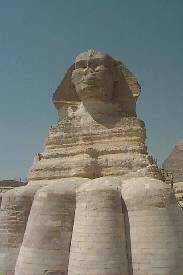
The Sphinx
of Giza is a symbol that has represented the essence of Egypt for thousands
of years. Even with all of the pictures that we see of the Sphinx, nothing can
really prepare you for the time that you finally see the Sphinx with your own
eyes. Here's a look at the Sphinx that will give you a hint of what you can
expect to see if you visit Egypt.
The
Great Sphinx of Giza
Carved
from the bedrock of the Giza plateau, the Sphinx is truly a mysterious marvel
from the days of ancient Egypt. The body of a lion with the head of a king or
god, the sphinx has come to symbolize strength and wisdom.
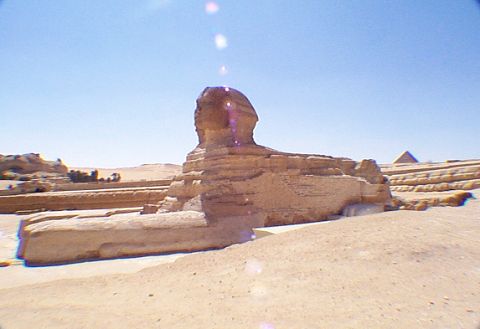
From
the north side the profile of the Sphinx reveals the proportion of the body
to the head. It would appear as though the head is small in proportion to the
body. Because of the changing desert terrain, the body of the Sphinx has been
buried several times over the past several thousand years. Most recently in
1905, the sand has been cleared away to expose the magnitude and beauty of the
entirety of the Sphinx. The paws themselves are 50 feet long (15m) while the
entire length is 150 feet (45m). The head is 30 (10m) feet long and 14 feet
(4m) wide. Because certain layers of the stone are softer than others, there
is a high degree of erosion that has claimed the original detail of the carved
figure.
The
most popular and current theory of the builder of the Sphinx holds that it was
commisioned by the 4th Dynasty King, Khafre. Khafre was one of the sons of Khufu
(AKA Cheops) who is recognized as the builder of the Great Pyramid. The Sphinx
lines up with the Pyramid of Khafre at the foot of its causeway. As one rounds
the northeast corner to the front of the Sphinx, the alignment of the two structures
becomes more apparent.
Although
the head of the Sphinx is badly battered in some places, traces of the original
paint can still be seen near one ear. Originally it is believed that the Sphinx
was painted and was quite colorful. Since then, the nose and beard have been
broken away. The nose was the unfortunate victim of target practice by the Turks
in the Turkish period. It is often erroneously assumed that the nose was shot
off by Napolean's men, but 18th century drawings reveal that the nose was missing
long before Napolean's arrival.
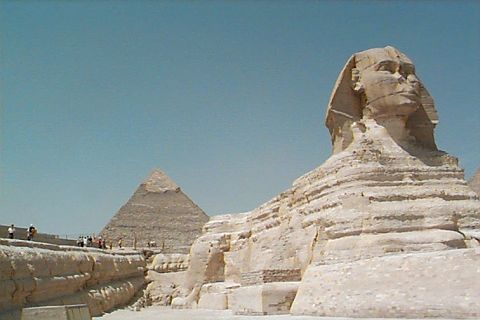
Rounding the southeast corner
Interestingly,
to some, the features of the face of the Sphinx bear a far more striking resemblence
to an older brother of Khafre, the Pharaoh Djedefre (AKA Radjedef). Djedefre's
short lived reign occured just prior to the reign of Khafre. Unlike Khafre,
Khafre's father and later Khafre's brother Menkara, Djedefre did not construct
his pyramid on the Giza plateau. Instead Djedefre built his pyramid at Abu Roash
where it now lies badly damaged. Some believe that Khafre usurped the throne
of Djedefre and then built his pyramid and Sphinx at Giza.
YOU
DECIDE who you think more resembles the Sphinx,
maybe neither?

Recently,
the Sphinx has undergone a major restoration effort, done solely by Egyptians.
Here is how the back right paw appears after this fine work. The top of the
paw was purposely left unfinished, which demonstrates the difference between
the original rock and the quality of the restoration. Also notice the tail of
the Sphinx which wraps around this right side.
The back right paw and tail
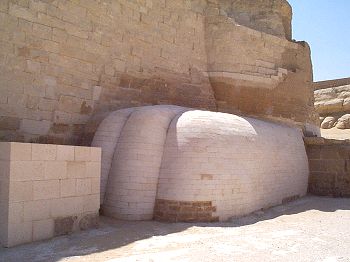
The
left or North side of the Sphinx was restored last, and here is how the left
paw appears now. Notice how carved bricks were use to perform the restoration.
These were hand cut and carefully fitted into place by modern day Egyptian craftsmen
and rock cutters.
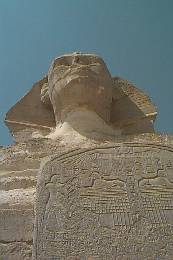
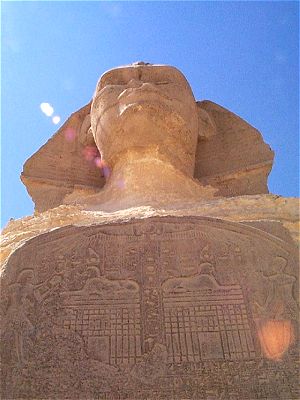
In
between the paws of the Sphinx is a stela, now called the "Dream Stela",
which is inscribed with a story. The 18th Dynasty story tells of the time that
Thutmosis IV fell asleep under the Sphinx which was covered to the neck in sand.
Thutmosis had a dream that the Sphinx spoke to him and promised that if he would
free the Sphinx from the sand, Thutmosis would be destined to become king of
Egypt.
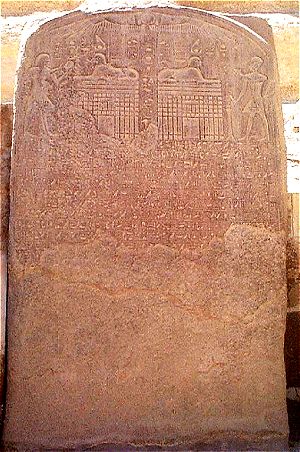
Prior
to the 1905 clearing of the Sphinx, the Sphinx has been buried by the desert
sand and cleared several other times throughout history. During the 18th Dynasty,
Thutmosis IV probably did clear the Sphinx at that time. But it is more likely
that the story about the dream was created for political purposes, an ancient
propaganda story to help prove the legitimacy of the king. This type of story
could support the validity of a kingship, asserting and assuring the power of
the pharaoh as designated by the gods, or in this case, the Sphinx itself.
Return
to Giza
Special thanks to:
Guardian's Egypt - Copyright © 1995-99 Andrew Bayuk All Rights Reserved
|





